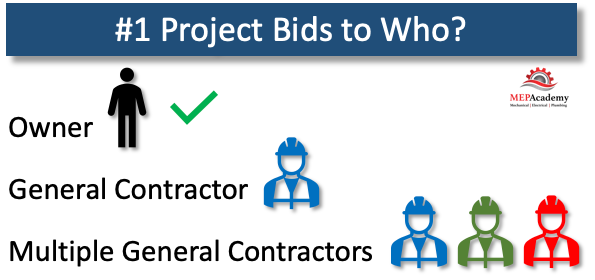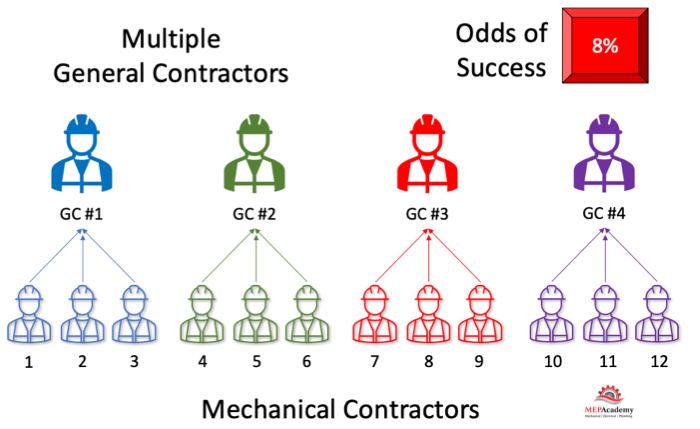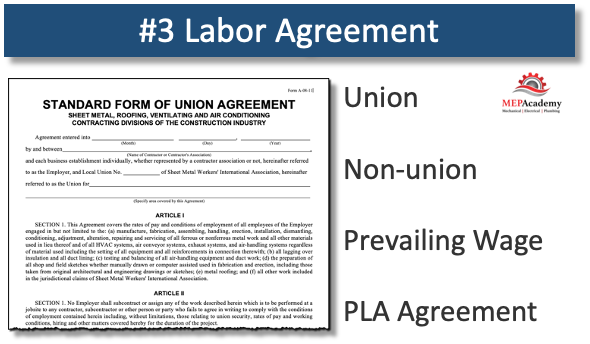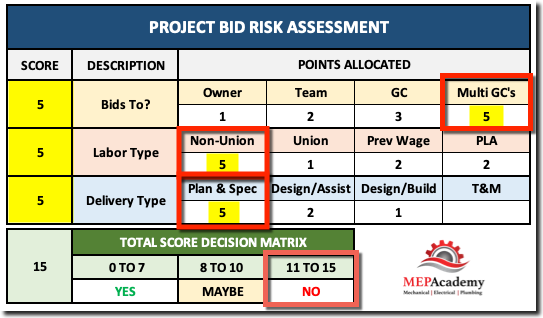The Cost of Bidding Work
Bidding on projects takes time and money, so it’s important you focus on those projects that you have the highest chance of being the successful bidder. So, how do you analyze a project for success?
I’ve been doing this for over 40 years and my companies have spent from a few thousand to over a hundred thousand dollars (+$100,000) to bid one commercial project. Small residential projects take very little effort to bid, but once you start bidding commercial projects the time involved and cost begin to climb higher. No matter what size the project, there is a cost of time and money to pursue it.
You need some way to determine what projects to pursue and which to pass on, because you can’t bid everything. The more time you spend chasing bad projects, the less time you have to win good projects. This is the lost opportunity cost of making the wrong decision.
You need to keep track of which projects you are successful on and why. So how do you make the right decision or at least improve your odds? Here are the top 3 things to consider before spending time and money pursuing a project to bid.
#1 Who Are You Bidding To?
Your typical bidding options are to bid directly to the owner, to a single General Contractor or, to multiple general contractors. Obviously, the least risk involves bidding directly to the owner, the decision maker. The least favorable options are bidding to a long list of general contractors.
The more general contractors involved in the bidding process the worse it gets for any chance of winning the job or making a profit. The winning bid will often be ridiculously low, making it hard to earn a profit. You’ll waste time managing and building a project for little to no profit. Your time is better spent pursuing more profitable work. Checkout the Top 12 Construction Bidding Websites to find commercial projects to bid on, from private to public works.

Direct to Owner (Best Option)
Bidding directly to an owner is often the case in residential construction but less likely in commercial construction. This removes any middle layers of decision makers that might have biases or add additional competitors. Often owners will seek 3 or less bidders, giving you a fair chance of winning the bid.
If your bidding Federal, State, City or Public works projects then the competition can be a few to many depending on the response to the RFP (Request for Proposals). In these cases you could be bidding direct to owner (Public Entity) if the focus is on one of the MEP trades, or to general contractors if there is significant work in other trades.
In commercial construction the chances of bidding directly to the owner is usually based on previous relationships established with the owner from possible service or maintenance work you’ve done at the site. If you are the current maintenance contractor for their equipment, then you have a fair chance of always bidding on their work or being the sole bidder.
This is one of the reasons why it’s important to have a service side of your business. You’ll get pull-through work, which comes from being on site and familiar to the owner, limiting your competition.
Cold calling is a tough business, but it works if you are tenacious and consistent.
Here are some of the other choices.
General Contractor has Project
This is where the general contractor has already successfully secured the project and is now seeking subcontractor quotes. This is a lot better than the multiple general contractor approach as at least there is only one GC, reducing your risk.
You need to make sure that you’re not just a check number. I know that this happens in the industry way too often and isn’t fair to those who are being used to price check someone who is being offered the job. Remember the general contractor already won the project, so it’s possible he has used a friendly Mechanical contractor to provide the budget to win the project or the GC used his own values or, it’s playing the role of CM (construction manager) with no role in any part of the installation.
Multiple General Contractors
This is of course the worse possible scenario as the odds of winning and making a fair profit are much less unless you’re working out of your garage and can beat your competition on overhead. With multiple general contractors, each of whom has a favorite mechanical contractor, making success tough, and even if you were successful with a low bid, it’s going to have to be low amongst a dozen or so other mechanicals. Not a great game plan to be in business very long.

If you have 6 generals contractors bidding on a project and each of them invites three mechanicals, you could be competing against 18 other mechanical contractors.
#2 Delivery Method
There are basically three delivery methods that are involved in commercial construction: Plans and Specification: Design/Assist: Design/Build. I’ll briefly cover their definition, but a full understanding of their meaning is beyond this article.

Plans & Specifications Delivery Method (P&S) (Worst Option)
Most contractors are aware of the Plans and Specifications (P&S) method of bidding, whereby an owner hires and engineer to develop a set of drawings that you bid off. Your contractual obligations are defined by what the engineer has put on the drawings and in the specifications, limited by your proposal language. Any scope of work not reflected on the plans and specifications would be considered a change-order.
You can find commercial plans and specification project to bid on by checking out the Top 12 Construction Bidding Websites to bid on, from private to public works.
Design/Assist Delivery Method (D/A)
This is when the engineer provides bridging documents that are partially completed but spell out the intent of the project. Drawings will be minimal if at all. Equipment maybe selected or not, but usually the size and type of system is defined, or system options are provided. You will participate in the process by giving your constructability review comments.
Design/Build Delivery Method (D/B) (Best Option)
This delivery method is where the contractor takes responsibility for the design and installation of the complete project. You can use a third-party engineer as part of your team, but you guide the design and are responsible for a complete operating system.
Out of the three types of delivery methods which ones have you been most successful at pursuing, winning, and earning a fair profit at building? If you were to rate them, what score would you give each between the value of 1 and 5, with 5 being the riskiest and least successful?
If you have never pursued a Design/Assist (D/A) or Design/Build (D/B) project than that limits you to the Plans and Specifications (P&S) delivery method. I believe my experience has been that the Design/Build delivery method has earned my companies the greatest profit margins. This is because you control every aspect of the project from design to construction and its usually a lot less competitive than P&S.
Tracking your delivery methods and the margins or profits you earn from the various delivery methods will allow you to make an inform decision on which to pursue. One of the companies goals I was involved in with, was the pursuit to be a 100% Design/Build contractor and eliminate any Plans and Specifications work unless it truly fit our other criteria.
The next criteria to review and put a score to is what are the required labor agreements?
#3 Construction Labor Rate Agreement
This comes down to the competitiveness of your labor rates to those of your competition. You must know what type of labor is acceptable to the project because it could put you at a great disadvantage.

Union vs Non-union Contractor
If you’re a Union contractor, then you want to know ahead of time if the project is accepting non-union bids. As a Union contractor you are obligated to pay wages according to your bargaining agreement. A Non-union contractor can pay their employees whatever the market will bear. If you’re a union company than it’s a waste of time to bid on labor intensive projects if you’re competing against a non-union company.
Prevailing Wages or PLA (Project Labor Agreement)
What can equalize the labor rate inequalities is if there is a mandate that sets a minimum labor rate for each type of skilled worker. A project requirement to pay prevailing wages or pay according to a Project Labor Agreement (PLA) attempts to provide a fair wage for anyone working on that project.
Be careful if you are a non-union contractor bidding a public project where these types of agreements are normally found, as the labor rates you’ll need to pay your workers are much likely higher then you’re currently pay. You will most likely be responsible to provide certified payroll records, so there is no getting around this requirement.
Your risk assessment will depend on whether your company is union or non-union or if there is some form of published labor rate that you must comply with.
The Top 3 Questions
The top three questions that you must ask yourself before deciding to bid on a project are.
- Who does the project bid to?
- What Type of Delivery Method?
- What are the labor requirements?
You can give a point value to each of these categories of risk to determine an overall project score. If the score falls within a certain range than you either pursue the project or pass on bidding it.
Bid Risk Assessment Rating
Having a bid risk assessment form to determine a weighted value that corresponds to the risk level or success of winning a proposed project will save you time and money. Even if you have an established business you need to make sure that the individuals responsible for bringing in the work to bid on is in your strike zone.
Having a simple numbering system where you give a score for each of those things that are important for your success. Below is a simple bidding score card to determine whether or not to pursue the work. This can be a general guide for your estimators. Any score not falling within the definite “Yes” category would require managements approval to pursue. You can find a similar Bid Risk Analysis form within the MEPAcademy Estimating Spreadsheet.

Allocate points to each category that matches your risk. I have shown values that effect a Union contractor in my particular situation. I rate the following as the worst possible scenario for a Union contractor (Multiple General Contractors, Non-union Bidders, Plan & Specifications delivery method). Total points for me = 15 (No Bid)
There are always other circumstances that the chart doesn’t reflect that may allow for pursuing those that score horribly, but generally the score reflects the risk of success.
Don’t forget to checkout the Top 12 Construction Bidding Websites to find commercial projects to bid on, from private to public works.







